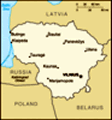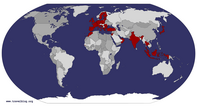Advertisement
Hello my fellow travellers!
As I mentioned yesterday I would spend this day following the traces of a genuine hero that I expect all to few know about, the name of that hero is Chiune Sugihara. For you that haven't heard of him before, he was a Japanese diplomat that was sent to Lithuania in 1939.
When Hitler rose to power and invaded Poland a lot of Jews realised where the winds where blowing and fled to Lithuania, set on fleeing through Russia to the Dutch colonies where they would be safe. There was only one problem, to get an exit VISA from Russia they were required to have a transit VISA for Japan since Japan occupied Manchuria at the time. Hundreds of Jewish refugees showed up at the Japanese embassy, desperate to receive a VISA.
Sugihara didn't have the mandate on his own to issue these many VISA in such a short span of time, he needed approval from his superiors in Japan. Sugihara petitioned his government three times to be allowed to issue a VISA to all the refugees that had to flee but he was denied each time because the Japanese government didn't want to
get on the bad side with their German allies.
He couldn't for his conscience sake leave the desperate refugees to their fate so he took matters into his own hand, something very unique to the Japanese that value obedience very highly. He knew that time was of the essence since the Soviet forces was advancing to take control of the Baltic countries and once that happened he would be unable to keep issuing VISA. He set to work, labouring between 18 and 20 hours every day to issue a VISA to everyone in need.
Remember that this was before the time of computers, all of these had to be written and approved by hand and he worked tirelessly, against explicit orders, to issue as many as possible. Before the Soviet forces finally invaded Lithuania and forced Sugihara to relocate to Berlin he issued over 2.000 VISA and it's estimated that he saved between 6.000 and 10.000 lives, because children travelled on the adults VISA as well.
He knew he took a great risk to do this against the will of his authoritarian government yet he stated afterwards that he would do it again if needed. As he
was forced to relocate he kept signing the VISA applications even as he was boarding the train, a true dedicated humanitarian to the very last of his ability.
You also have to keep in mind that during all of this his own family was with him, sharing the same peril. He was later reassigned to Romania but when the USSR invaded Romania Sugihara and his family was sent to a Soviet prisoner of war camp for almost two years. Upon his release in 1946 he returned to Japan where he was asked to resign in 1947 due to the
Incident in Lithuania.
After the war ended many attempts was made by the people he saved to locate him but since he went under the more easily pronounceable name of
Sempo in Lithuania it took many years before he was finally found by one of the refugees he helped, the man still had his VISA, his most priced belonging ever since that day and he showed it to Sugihara in their emotional reunion.
In 1985, one year before his death, Sugihara was named
Righteous Among the Nations by Israel, the only Japanese ever to be named so.
My plan for the day was to first go to
Kauno Vandenys, the municipal water supply, to pay homage to the monument to Steponas Kairys. He was the engineer who was responsible for creating the water supply system of Kaunas in 1920. The reason why I included him on my itinerary this day is because he published the first book about Japan in Lithuanian and thereby created the ever growing ties of love between Lithuania and Japan. As such he is certainly worthy of remembrance, not to mention that he was actually one of the 20 signatories of the Act of Independence of Lithuania in 1918.
From the
Kauno Vandenys I followed the scenic
Kauko Laiptai downhill to go to the main attraction of the day, the house that Chiune Sugihara lived in and operated from during his time in Lithuania. It's complete with his furniture and work desk and I was allowed to sit behind the desk of the man who saved so many lives.
Reaching it wasn't smooth though, let us just say that Kaunas is very hilly and with very poor conditions on it's streets, this city is not even remotely suitable for biking and
I ended up carrying the bike more than it carried me. After climbing a hill from hell with my bike I was exhausted before I even reached his house, and the day had barely started. In Lithuanian his former house and embassy is known as
Sugiharos Namai which means Sugihara house.
I was genuinely lucky that it was open though, pretty much everything else I had on my list for the day was closed because it was the day after a public holiday, the summer solstice. Rūta, the girl who worked in the museum, checked up on all the other sites I planned to go to and they were all indeed closed. The only reason that the house was opened is because they have a lot of Japanese visitors and must always be ready to accept them.
Because of this I ended up stayed a long time there, mainly talking to Rūta, because we share a love for Japan and we will both be in Japan in October so I will try to arrange to meet her again then). She have already studied in South Korea for six months and will now study in Japan for one year.
I look forward to meeting her again and I wish that I had more time in Kaunas to spend with her.
When I eventually left
Sugiharos Namai I took a wrong turn though and found myself face to face with a coked out migrant who started shouting at me at a language I didn't understand and running after me so I booted out of there in a haste and made my way down the hill at full speed to the station,
Geležinkelio Stotis. The reason I went there is because I wanted to see the plaque commemorating Sugihara and his last efforts to save people as he was boarding the train.
With everything else on my list made unavailable by the state of affairs I decided to go for the
Nemuno Sala, a small island which has a Japanese garden that Chiune Sugihara frequented. Of course it wasn't blossoming now but on the way I took a look at
Šv. Kryžiaus Bažnyčia, a nice church from the 17th century and afterwards I continued to the
Vytauto Didžiojo Karo Muziejus, a large museum dedicated to the history of war, which was of course also closed.
Because I am
a masochist at heart, I guess, I decided to once again haul my borrowed bike up a really nasty hill to reach
Kristaus Prisikėlimo Bazilika, a really massive basilica situated up high with a grand view of Kaunas. I reached it more dead than alive and as I entered the church I saw that there was a roof terrace available, entrance was 1.2 euro if you took the stairs and 2.4 euro if you took the elevator. I checked my change, 1.6 euro. Lovely, stairs here I come! The cashier looked at me as if I was insane, a genuine look of disbelief, when I handed her 1.2 euro. I probably was insane but I did make it up and back down again without a heart attack and the view was certainly worth it! It has huge roof terrace that covers the full length of the basilica and you get a complete panoramic view of Kaunas from up here.
After this I really only had one sight left,
Devintas Fortas, which is a stronghold that is a part of the
Kauno Tvirtovė, the Russian fortifications built around Kaunas between 1887 and 1915. It saw action during World War I
and lasted for eleven days before falling to the Germans. It's also the largest fortifications in Lithuania so of course I really wanted to visit it. The problem though, was that it was located on the very opposite side of Kaunas, 10 km away and of course on top of yet another bloody hill! I was already completely exhausted from all the climbing, while carrying the bike around, so I debated long and hard with myself if I should go or not.
With some serious deliberation I decided that I would regret it if I didn't go there so with that I set out to find it. It took a long time, much sweat and several less than choice words but I did manage to reach it and it was totally worth it! The route there was really scenic, passing by several derelict houses an even an old manor,
Linkuvos Dvaras, it was a really fascinating exploration.
The fort itself was of course closed, but the grand memorial to the victims of the Holocaust standing outside more than made up for it! It stands 32 meters tall and it is an imposing and really awe inspiring monument. Despite
the best effort of men like Sugihara and his Dutch counterpart Jan Zwartendijk many still met a tragic end here and this monument is erected on the sight where more than 15.000 Jews was murdered between 1941 and 1945.
I felt quite satisfied with my day, even though most places were closed, I had a great day traversing Kaunas on bike even if the roads where more or less a death trap and I had to carry the bike more than it got to carry me. I was happy when I finally came back to the apartment though and could buy some well deserved food and snacks and relax with a good movie for the rest of the night.
Tomorrow I will head to Vilnius because I feel that I have now seen what Kaunas has to offer.
Until tomorrow I wish you all peace and happy travels!
Advertisement
Tot: 0.12s; Tpl: 0.014s; cc: 10; qc: 34; dbt: 0.065s; 1; m:domysql w:travelblog (10.17.0.13); sld: 1;
; mem: 1.2mb



























Kuan Yin
Karen Johnson
A hero indeed
I didn't know that a Japanese diplomat had worked so tirelessly to save Jews during WWII. A hero indeed. Thanks for the history.